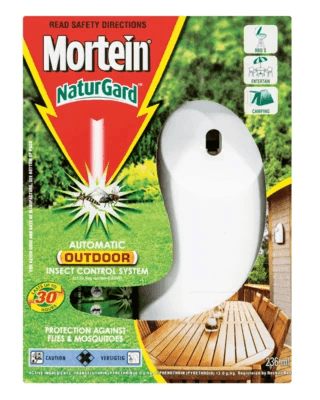
MORTEIN NATURGARD DISPENSER & INSECTICIDE SPRAY COMPLETE OUTDOOR
Includes dispenser and insecticide spray for automatic control of flies and mosquitoes so you can set and forget while enjoying pest-free time outside. Lasts up to 30 hours.
The most common fly in South African homes is the house fly (Musca domestica). There are over 150,000 known species of flies worldwide, and most likely, many more are still unknown. They have soft bodies, and most species are less than 1.5 centimetres long, but a few larger species can be up to 4 centimetres! Adult flies have only one set of wings.
The second pair has evolved into balancing organs that look like little clubs. All adult flies have large eyes to help them navigate their flight.
Adult flies drink nectar, but some eat any liquid that has nutrients, including blood from mammals. They can "spit" onto dry food to liquefy it, which is how they contaminate human food. A few species are predators, grabbing other insects and stabbing them to suck out nutrients.
If you're looking for pesky flies, you'll find them just about any environment. They can sense the presence of food from kilometres away. Female flies lay eggs on food for their larvae (maggots). As they grow, the larvae shed their outer layer of skin several times. When they have transformed into a pupa, they have a resting stage that turns into an adult.
Flies are important pollinators, and some fly larvae are crucial members of the natural “clean-up squad”, reducing the amount of dung and dead animals. Flies are also an essential part of many animals' diets.
However, they are not welcome in our homes because they can spread diseases like cholera, salmonella, tuberculosis and anthrax. They leave behind germs when they land on surfaces or when they excrete on them.
Common fly species in South Africa:
House Fly
House flies have no teeth, so they vomit on their food to digest it. They are usually found breeding in rubbish bins, compost heaps, and pet areas. They can travel up to 30km for food.
Bottle Fly
The common bottle fly lives near rotting matter and feeds on dead animals, faeces, garbage and decomposing plant materials. Bottle flies can also lay eggs in cadaver tissue.
Fruit Fly
Fruit flies, so-called because they enjoy fruit so much, have a short lifespan of only eight to ten days. Female fruit flies lay up to 500 eggs in one nest, usually found at places where food is being prepared, like restaurants or your kitchen at home.
Horse Fly
Horseflies are often found in suburban and rural areas near bodies of water. They typically breed near the water and live near mammals — which makes them a bothersome pest. Horseflies don't carry disease, but their bites can cause allergic reactions and be quite painful.
Expert Advice
You can prevent flies with one simple solution: clean up after your pets! Not only are their faeces a perfect breeding ground for flies, but they may land on your food before you do.
Fun Facts
Wonder why flies crawl all over your food? House flies have 10 million more sensitive taste receptors on their feet than humans do on their tongues.